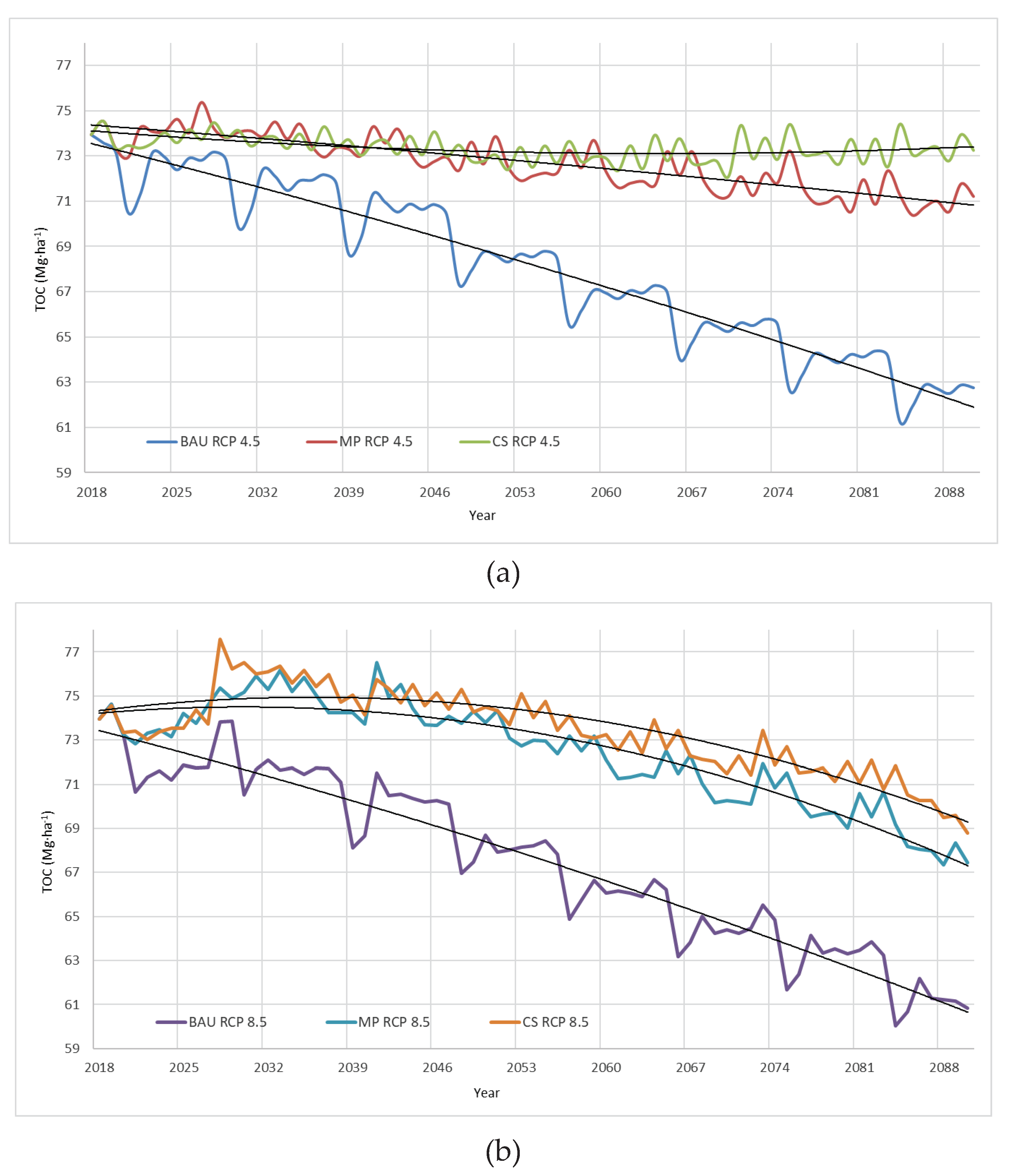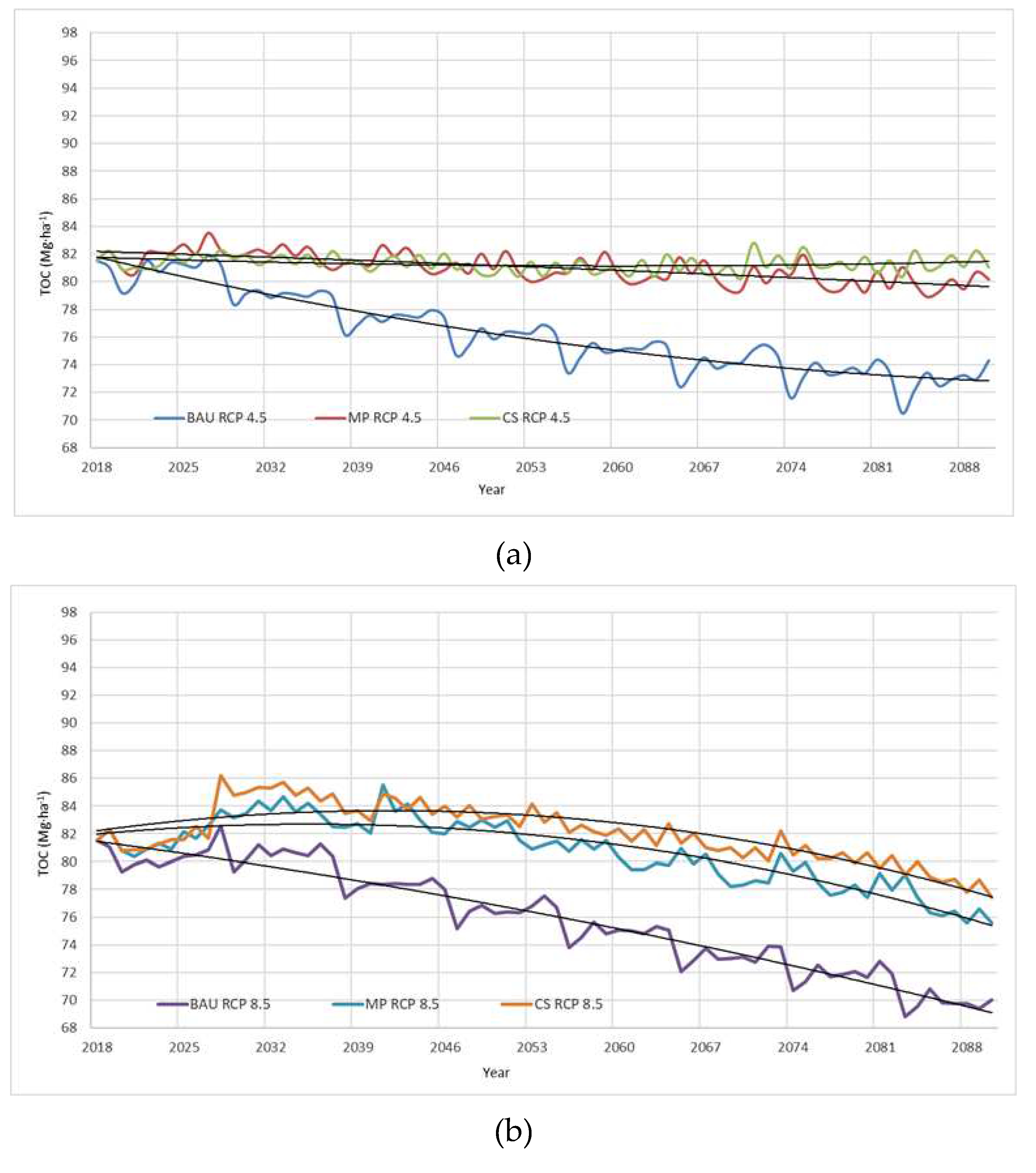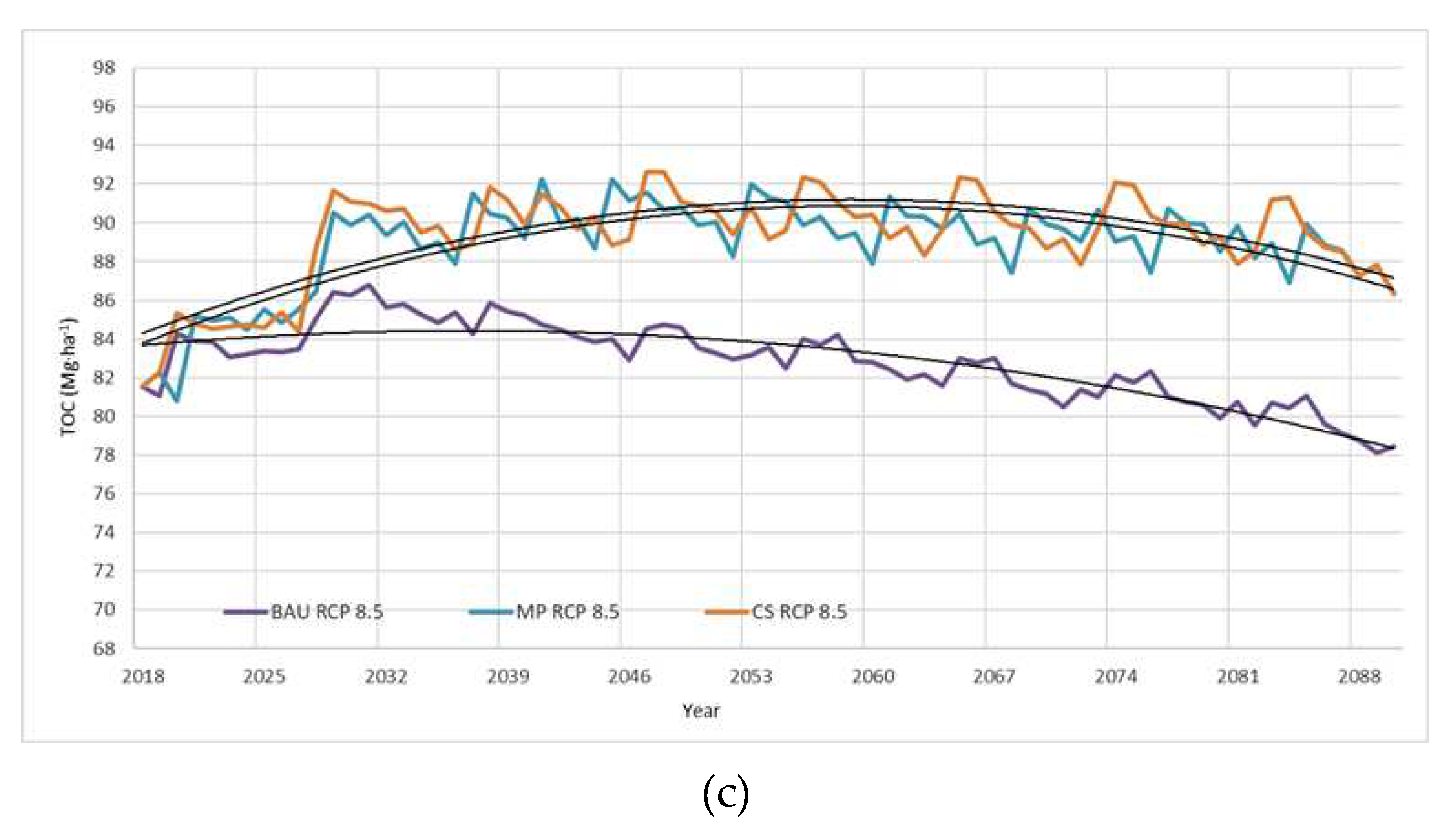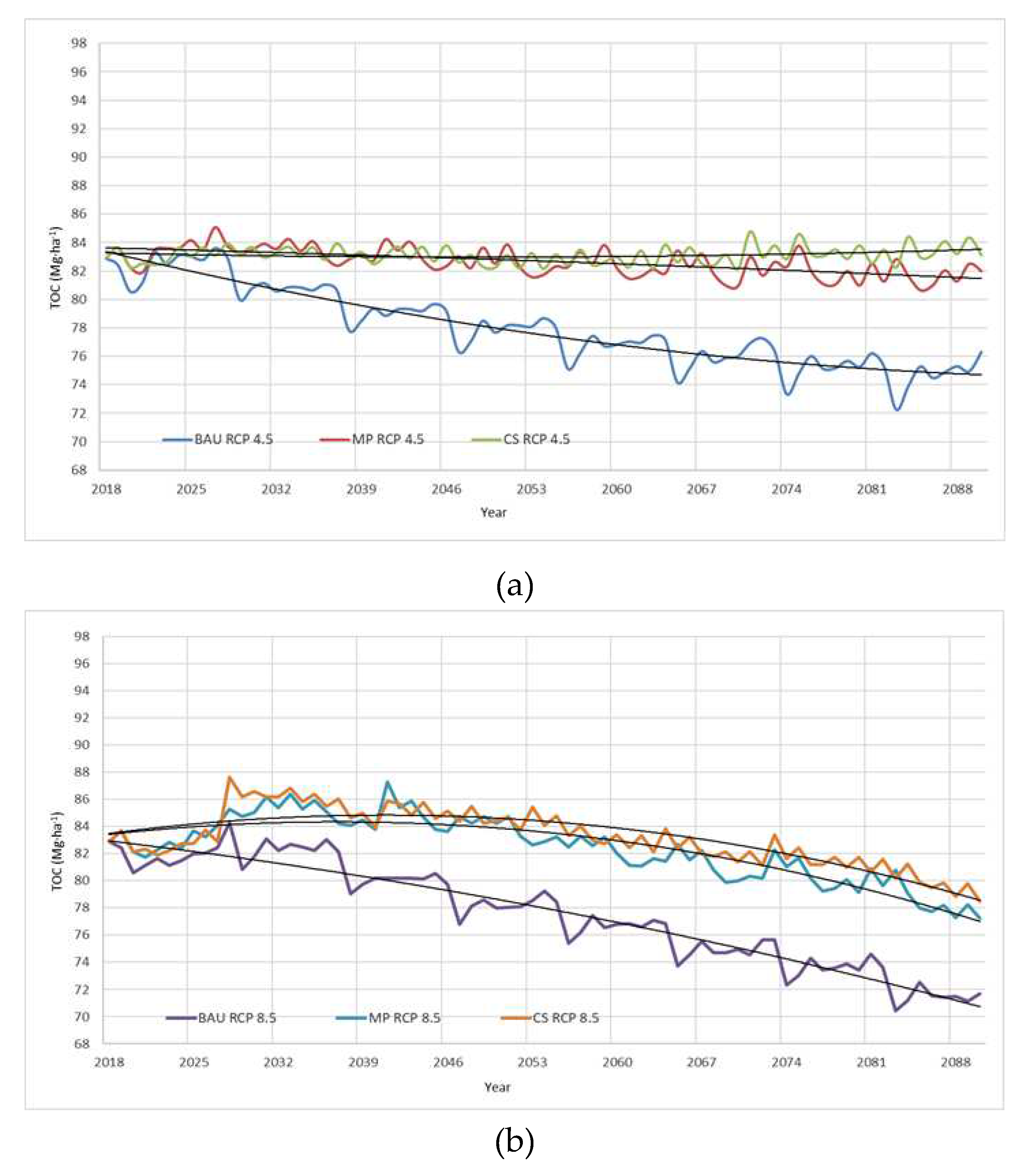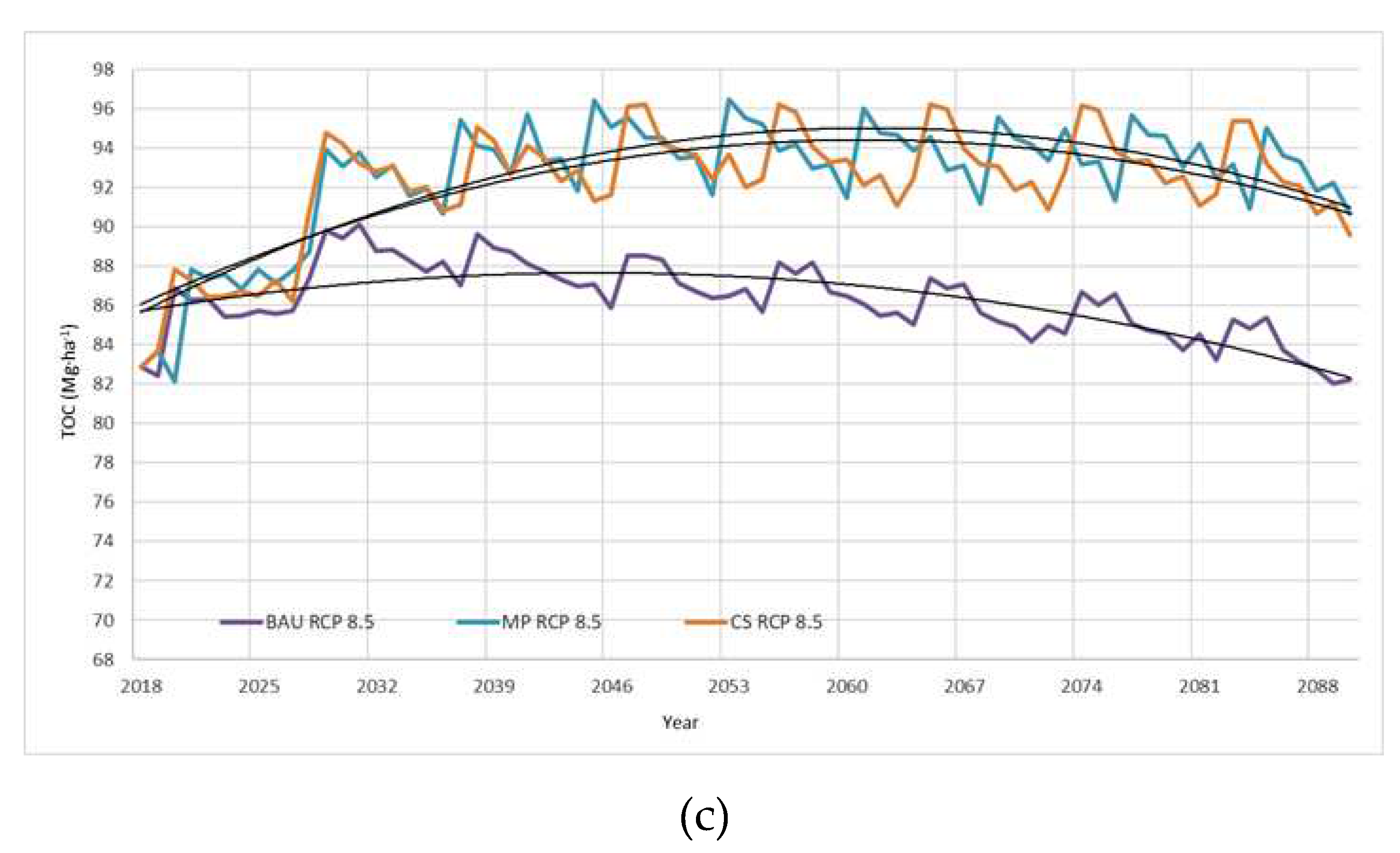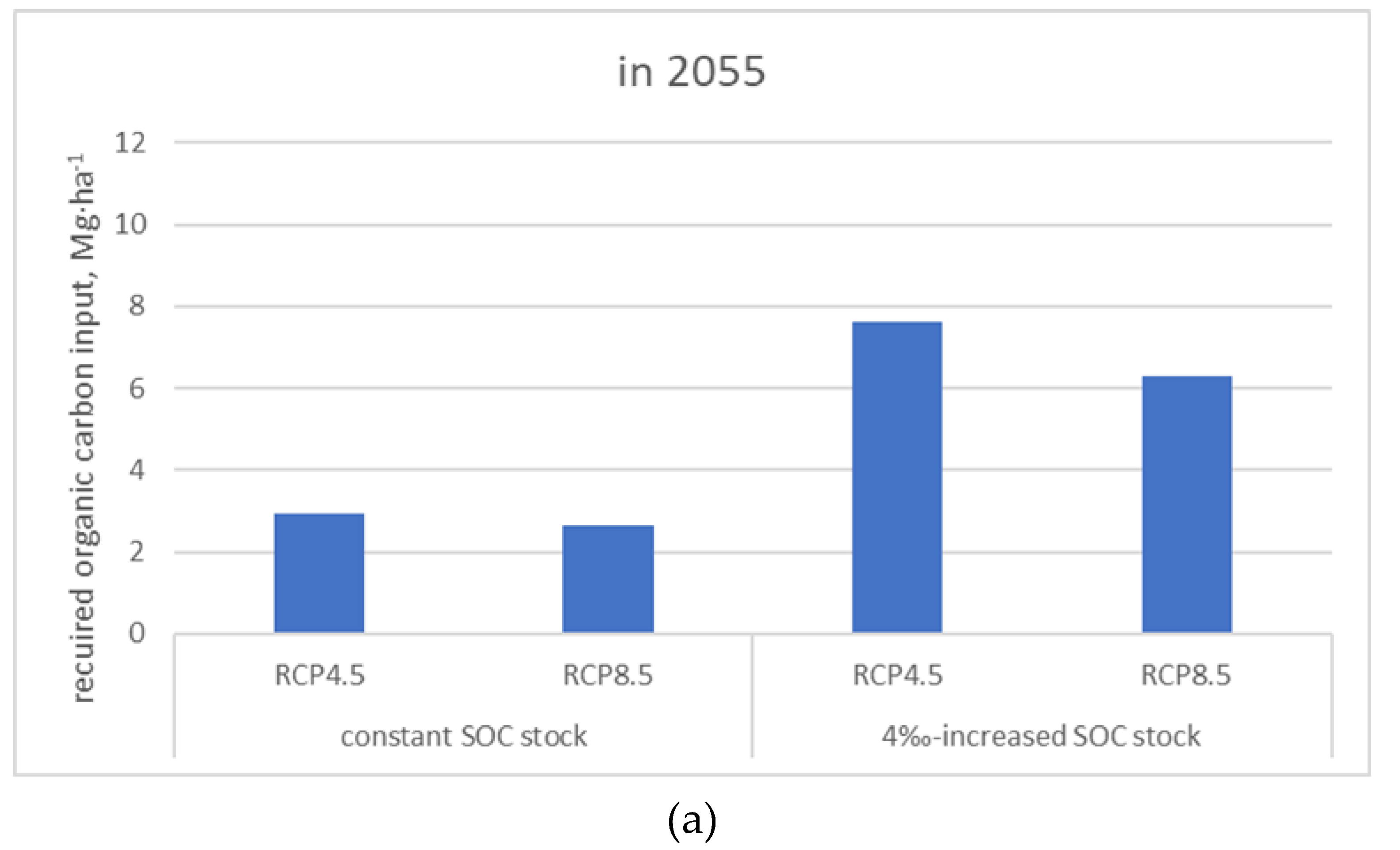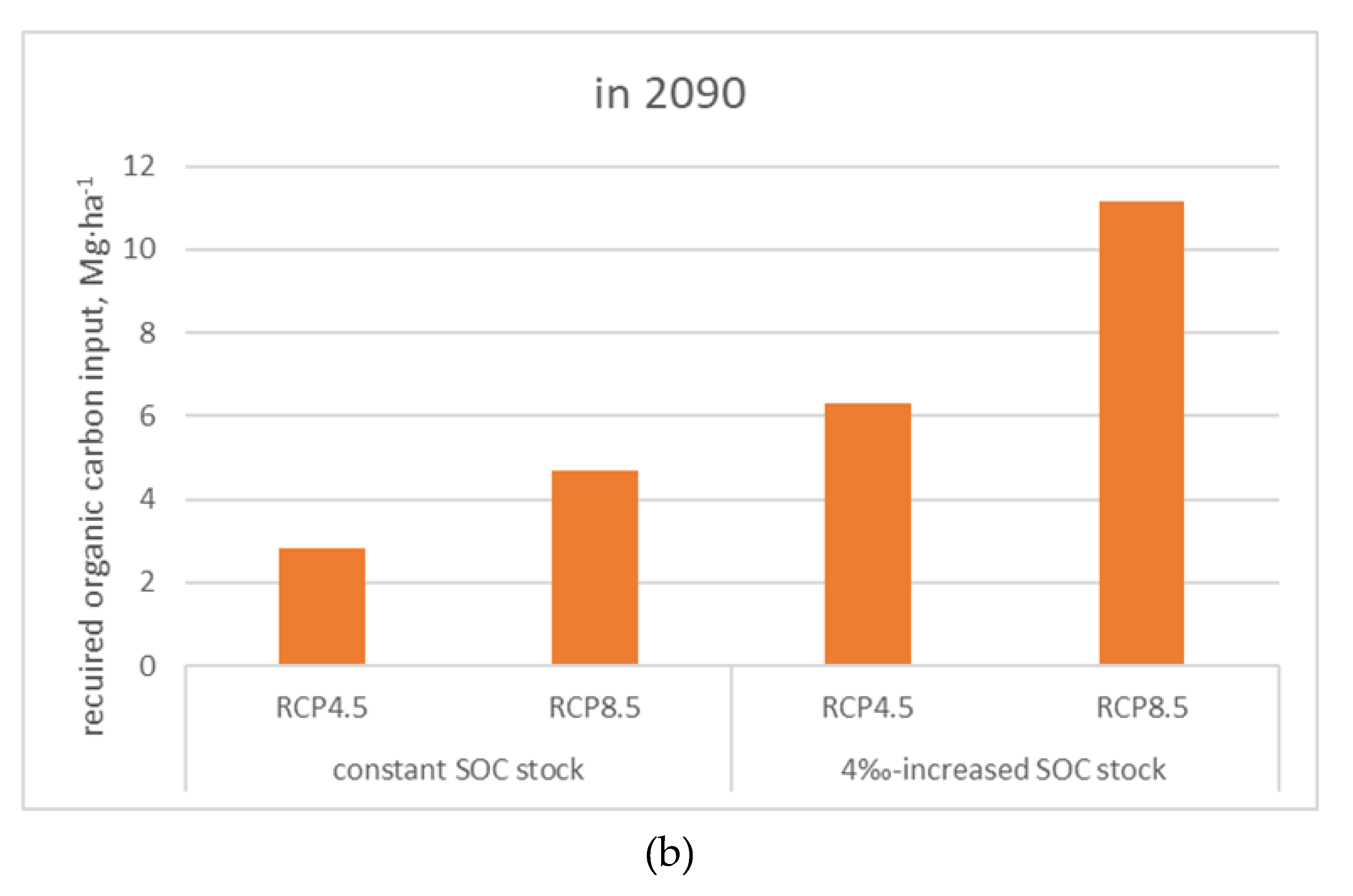1. Introduction
The perspectives for the use of conservation farming and advanced land use technologies in the management of C sequestration and storage has been the subject of numerous articles in recent years [
1,
2,
3,
4,
5,
6]. As noted by Chenu et al. [
1], the term «sequestration», representing negative emission technology, denotes a relatively long duration period, at least 20 years based on the recommendations of the Intergovernmental Panel on Climate Change (IPCC). The term “storage” has a broader meaning, indicating C accumulation in the soil, which is not always related to the removal of C from the atmosphere. For example, application of farmyard manure (FYM) originates from outside field does not reflect direct CO
2 removal at the site [
7]. In this paper, we discuss the perspectives for implementation of the 4 per 1000 initiative [
8] for arable Chernozem under future climate conditions. Since C loss from carbon-rich soils can be a significant source of CO
2 emissions, the increase in C storage in these soils presents an opportunity for adaptation and climate change mitigation [9, 10]. It is believed that C accumulation in mineral soils have a certain saturation level. Paustain et al. [
7] proposed 5% of soil organic C by mass as such criterion. Even when arable soils are below the saturation level, the high C content in such soils is commonly considered as a factor preventing further C accumulation. However, the evaluation of the effectiveness of changing management practices may be carried out at the regional level, where the loss of C in some areas can be offset by a corresponding increase in the other areas [
11,
12]. Thus, the soils with lower C concentration may compensate weak reaction of carbon-rich soils to the management practices. In real conditions within one field, many other restrictions arise. First, long-term application of management practices is necessary for increasing SOC stocks. These practices should provide a sustainable increase of C input [
13], which can be difficult to ensure [
7]. Interaction or cumulative effect of change in crop rotation, fallowing, residue management, and fertilization affect the balance of soil C stock [
14,
15]. A set of practices that provide consistent C storage compared to business-as-usual (BAU) cropping systems, should be economically justified [
6]. Secondly, the accumulation of C may slow down when a new equilibrium state is reached [
7]. Thirdly, the rate of mineralization of organic matter may increase, which is controlled at the local level by a set of other factors compared to regional estimates [
16]. In this case, it becomes important to assess the comparability of the impact of climate change and agricultural practices on the processes of mineralization and stabilization of SOC locally in the long term [
17]. Previously, we reproduced the dynamics of SOC in a long-term field experiment (LTFE) on Chernozem in the Rostov region until 2020 [
18]. In the present paper we present a simulation for the period up to 2090 for the same experimental plot on Haplic Chernozems. The aim of this simulation was to assess the possibility of consecutive SOC storage and a SOC stock increase of 4 per 1000 in the LTFE under planned management practices change. It is based on dynamic modeling of SOC stocks for three contrasting LTFE treatments with average and high fertilization rates, considering two climate change scenarios and three management scenarios to investigate their effects in combination. Special attention was paid to estimating the necessary C input and its practical feasibility for preservation or increasing SOC stocks over different time frames. We also analyze if the required C input level can be achieved with crop rotation changes or with additional organic fertilization.
2. Materials and Methods
The study is based on the long-term field experiment of the Geographic Network of LTFE with Fertilizers [
19]. The LTFE was launched in 1974 by the Federal Rostov Agricultural Research Center. A detailed description of the experimental field and experimental treatments used to conduct simulation modeling and predict the dynamics of soil organic carbon (SOC) stocks is presented in our previous work [
18]. Briefly, the experimental site is situated on a watershed plateau in the central part of the Rostov oblast near the village of Rassvet, Aksai District, 20 km from the Don River. Current rotation includes black fallow, winter wheat, maize for grain, spring barley, maize for silage, winter wheat, peas, winter wheat, and sunflower. The SOC stock in the 0–30 cm before the launching the experiment was 88.5 Mg·ha
-1. Three treatments of the LTFE were used for simulation: a control without fertilization (control), 80 Mg·ha
-1 of FYM + N
330P
190K
190 on average per crop rotation (treatment 8), and 100 Mg·ha
-1 of FYM + N
580P
330K
330 on average per crop rotation (treatment 11). C gain according to the 4 per 1000 initiative was observed in the first 20 years for the treatment 11, with an annual input of 4.3–5.7 Mg·ha
-1 of C from crop residues. Additionally accumulated C was lost in the last two rotations after reducing rates of organic fertilizers [
18]. A database of this experiment was constructed in the EuroSOMNET (European Network of Field Experiments on Soil Organic Matter) format [
20]. In this study, we used the Rothamsted model RothC version 26.3 for the evaluation of SOC. The model considers the effects of soil clay content, monthly temperature, precipitation, evaporation, and C input on the SOC cycle. The initial equilibrium run of the model to match the initial C content provides SOC partitioning across four variable pools, while SOC of the inert pool is controlled by soil clay content. Our previous papers [
18,
21] include a description of the model, a list of data required for simulation modeling, the results of the model verification based on the experimental data, and a statistical evaluation of the simulation results with the Modeval model. The two climate change scenarios include the Representative Concentration Pathways (RCPs) used in the IPCC Fifth Assessment Report: RCP4.5 and RCP8.5 [
22]. The first scenario describes moderate changes in the concentration of greenhouse gases in the atmosphere as a result of climate mitigation (650 ppm CO
2-eq at stabilization after 2100), while the second scenario assumes no effective climate mitigation with 1370 ppm CO
2-eq by 2100 [
23]. Climate data for the LTFE were calculated using the “Climate–Soil–Harvest” model based on regional data from the ensemble scenario from 31 global models in CMIP5 [
24]. Predicted climate variables on temperature, precipitation, and potential evapotranspiration were used with monthly resolution up to 2100. For simulation of future yields for the three treatments up to 2090 separately for each crop, we used the Selyaninov hydrothermal coefficient (HTC), which was widely applied for estimation of moistening the territory from drought to excess moisture and used as an indicator of the availability of moisture for plants [
25]. The calculation methodology, which also accounts for the long-term technological trend, is described in detail in Prokopyeva et al. [
26]. The predicted yield for each crop in rotation was used to calculate the carbon input from plant residues using Levin’s approach [
27]. Three economic assumptions were considered adaptation scenarios (AS). The first involves changing the structure of agricultural production to ensure maximum profit return (MP). The second imposes a limitation on profit growth by the condition of ensuring a constant or increasing SOM content—Carbon maintenance or sequestration (CS). Adaptation includes planned changes in crop rotation and/or organic fertilization rates. For the last obey, we assumed that economic characteristics would remain unchanged at the current level, accounting for changes in climatic conditions (BAU). A current nine-year rotation of crops (BAU) includes 33% row crops, 67% cereals, and 10% fallow. The MP scenario assumes 25% row crops and 75% cereals, while the CS scenario—33% row crops and 66% cereals. The first adaptation scenario is based on an eight-year crop rotation with the following crops: winter wheat, peas, spring barley, maize for silage, winter wheat, peas, winter wheat, and sunflower. Crop rotation in the second scenario: winter wheat, peas, grain maize, spring barley, maize for silage, winter wheat, peas, winter wheat, and sunflower. Both alternative rotations have no fallow period. The scenarios were drawn using an economic predictive model that considers both expected climate change and the dynamics of SOC stocks. The outputs of economic modeling are the following: crop rotation structure by crop groups, application rate of FYM per rotation area, initial and final SOM content, and average specific profit per 1 ha.
To create adaptation scenarios, the following equation for the carbon balance was used [
28]:
where x
2, x
3, x
4, x
5, x
11, x
12 are the percent of perennial grasses in the crop rotation (%); FYM rate per hectare of crop rotation, 75% moisture content (Mg·ha
-1); N fertilizers rate, kg·ha
-1; % of cereal crops in the crop rotation; % of row crops in the crop rotation; bare fallow % in the crop rotation, respectively.
The coefficients included in the balance equation have the form:
Details of economic modeling for planning the annual crop production in an agricultural enterprise, including SOM dynamics as additional economic and environmental criteria, are described in detail in Siptits et al. [
29,
30]. Thus, for each LTFE treatment, the SOC simulation for 2018–2090 was based on 2 RCP x 3 AS. The modeling was performed from January 2018 to December 2090 in a monthly time step.
3. Results
The average yield and the yield ranges for various crops obtained during the experimental period from 1975 to 2018 are presented in
Table 1. One can observe a regular increase in crop yields with an increase in organic and mineral fertilizer application rates in treatments 8 and 11.
Winter wheat and spring barley were the most responsive to fertilization (yield growth by 45% and 47%, respectively), while maize for silage was the least responsive (27%). The biggest increase in yield compared to the control was observed for treatment 8 with the average rate of fertilizers. A further increase in fertilization (treatment 11) resulted in only a 2-11% increase in yield.
For the predicted yield up to 2090, obtained for RCP4.5 and RCP8.5 scenarios, the maximum effect of climate change is expected for the yield of grain maize (an increase of 48–69% to the average values during the experiment), and the least gain will be for winter wheat (an increase of 9–19%). In reality, the increase in the wheat yield may be less pronounced due to fallowing elimination, and planting of wheat after sunflower in the alternative crop rotations. A decrease in yields in future climates is predicted for maize for silage (up to 25%), peas, sunflower, and spring barley (12-14%). The decline is predicted to be proportional to the currently observed yields for all the treatments. For grain maize and winter wheat, a slightly higher increase in yield is expected for the control compared to fertilized treatments. Relative differences in average predicted yields under the RCP4.5 and RCP8.5 scenarios do not exceed 1% (
Table 2 and
Table 3).
The initial SOC stock in 2018 in the 0–30 cm layer corresponded to 73.9, 81.5, and 82.9 Mg∙ha-1 in the control, 8, and 11 treatments.
An analysis of SOC stock dynamics for the period 2018–90 was carried out, analyzing the effects of crop rotation, application of organic fertilizers, and bare fallow under different scenarios of the future climate on the ability of the studied soils to accumulate organic matter and the possibility of achieving an annual increase of 4‰ [
8].
Figure 1 shows the dynamics of carbon stocks in the plow horizon, calculated for two climate change scenarios and three adaptation scenarios (BAU, MP, and CS) for the control treatment of the LTFE.
For both climate scenarios, there is a gradual decrease in SOC stocks (
Figure 1), but under the RCP8.5 scenario, there is a higher rate of SOC stock decline and sharper fluctuations in values associated with fallow. By the end of the simulated period, the difference between the SOC stocks was 1.4, 3.3, and 4.3 Mg·ha
-1, for the BAU, MP, and CS adaptive scenarios, respectively.
Starting in 2018, carbon stocks forecasts were performed over a span of twenty years for calculating the rate of SOC dynamics and carbon input (
Table 4). Such a period is usually considered for evaluating the effectiveness of the “4 per 1000” initiative [
8]. The smallest absolute or relative changes in SOC are observed under the MP adaptive scenario and the RCP4.5 climate scenario. By 2090, SOC stocks will remain at the same level as in 2018. This fact allows concluding that even without fertilization, stabilization and even an increase in SOC in the arable layer of Chernozem can be achieved with a properly selected crop rotation. The maximum increase in the absolute SOC values is expected in the first twenty years with the rotation selected for the CS adaptation scenario and the RCP8.5 climate scenario (
Table 4). The largest average annual relative increase in SOC stocks, equal to 0.95‰, is predicted for the period of 2078–90 under the MP adaptation scenario and the RCP4.5 climate scenario (
Table 5). The smaller proportion of row crops set for the MP rotation shows a higher rate of relative increase in SOC stocks in the final 20-year simulation period, although it results in smaller SOC accumulation by 2090. This suggests that under the CS adaptation scenario, equilibrium may be achieved several decades earlier than under the MP scenario. It is noteworthy that the simulation results confirm the conclusion of our previous study, conducted on LTFE on Luvic Chernozem, that crop rotation has a greater impact on SOC stock dynamics in comparison with climate change [
21].
For treatments 8 and 11, we also simulated the impact of both changes in crop rotation and the application of organic fertilizers on the SOC stock dynamics.
Figure 2 and
Figure 3 show the dynamics of SOC stocks in the arable layer of treatments 8 and 11, respectively, calculated for the RCP4.5 and RCP8.5 scenarios without organic fertilization and for the RCP8.5 scenario with the use of organic fertilizers.
Figure 2 and
Figure 3 show similar patterns of the predicted SOC dynamics for both treatments, which is explained by similar conditions in the amount of crop residues and C inputs with only a slight difference. The initial SOC stocks were 81.5 and 82.9 Mg·ha
-1 in treatments 8 and 11, respectively. The graphs show a significant increase in SOC stocks when FYM is used at rates of 80 and 100 Mg·ha
-1 per crop rotation in 8 and 11 treatments, respectively. Both absolute and relative estimates of changes in SOC stocks in the first twenty years show drastic increases (tables 6 and 7). The RCP4.5 climate scenario and a properly selected crop rotation allow maintaining SOC stocks at an equilibrium level of 80–82 Mg·ha
-1 and 82–84 Mg·ha
-1 for 8 and 11 treatments, respectively, even without organic fertilization. But achieving the 4 per mille indicators is possible primarily when FYM or other organic fertilizers are applied (Tables 4, 6, and 8).
As shown in tables 6 and 8, the maximum C gain in absolute values was recorded in the first twenty years under organic fertilization for the RCP8.5 scenario. SOC stocks increased by 9.4 and 9.5 Mg·ha-1 in treatment 8, and even higher in treatment 11 (by 11.8 and 10.9 Mg·ha-1 in MP and CS adaptation scenarios, respectively). If we compare the values obtained for the RCP8.5 scenario with and without FYM application, for both options in the first twenty years (2018-38), the SOC accumulation rate increases 8-9-fold. In the next twenty years, for the RCP8.5 scenario in both treatments with FYM, equilibrium will be reached with higher SOC stocks than without organic fertilization. The values vary in the range of 88-91 and 91-95 Mg·ha-1 in treatments 8 and 11, respectively, which is on average 10 and 13 Mg·ha-1 higher than in the treatments without FYM application.
Table 6.
Absolute changes of SOC storage under application of 80 Mg∙ha-1 FYM (treatments 8). RCP: Representative Concentration Pathways.
Table 6.
Absolute changes of SOC storage under application of 80 Mg∙ha-1 FYM (treatments 8). RCP: Representative Concentration Pathways.
| Period |
Treatment 8 |
| Absolute changes, Mg·ha-1
|
|---|
| BAU |
MP |
CS |
| RCP4.5 |
|
|
|
| 2018–2038 |
−3.90 |
−0.34 |
0.48 |
| 2038–2058 |
−1.30 |
0.04 |
−0.33 |
| 2058–2078 |
−2.04 |
−1.67 |
0.22 |
| 2078–2090 |
0.26 |
0.81 |
−0.15 |
| RCP8.5 |
|
|
|
| 2018–2038 |
−2.65 |
1.03 |
2.82 |
| 2038–2058 |
−2.41 |
−1.17 |
−1.01 |
| 2058–2078 |
−3.52 |
−3.08 |
−1.94 |
| 2078–2090 |
−2.07 |
−1.79 |
−2.59 |
| RCP8.5 + FYM |
|
|
|
| 2018–2038 |
3.89 |
9.42 |
9.46 |
| 2038–2058 |
−1.39 |
−0.45 |
0.26 |
| 2058–2078 |
−2.80 |
1.35 |
−1.06 |
| 2078–2090 |
−2.52 |
−3.13 |
−2.99 |
Table 7.
Annual gain or loss of SOC storage under application of 80 Mg∙ha-1 FYM (treatments 8). RCP: Representative Concentration Pathways.
Table 7.
Annual gain or loss of SOC storage under application of 80 Mg∙ha-1 FYM (treatments 8). RCP: Representative Concentration Pathways.
| Period |
Treatment 8 |
| Annual Gain/Loss, ‰ |
|---|
| BAU |
MP |
BAU |
| RCP4.5 |
|
|
|
| 2018–2038 |
−2.40 |
−0.21 |
0.30 |
| 2038–2058 |
−0.85 |
0.02 |
−0.20 |
| 2058–2078 |
−1.35 |
−1.03 |
0.13 |
| 2078–2090 |
0.18 |
0.51 |
−0.09 |
| RCP8.5 |
|
|
|
| 2018–2038 |
−1.63 |
0.63 |
1.73 |
| 2038–2058 |
−1.55 |
−0.71 |
−0.60 |
| 2058–2078 |
−2.34 |
−1.91 |
−1.18 |
| 2078–2090 |
−1.44 |
−1.15 |
−1.61 |
| RCP8.5 + FYM |
|
|
|
| 2018–2038 |
2.39 |
5.78 |
5.81 |
| 2038–2058 |
−0.81 |
−0.25 |
0.14 |
| 2058–2078 |
−1.67 |
0.76 |
−0.58 |
| 2078–2090 |
−1.56 |
−1.75 |
−1.67 |
The maximum SOC accumulation depends primarily on crop rotation and, to a lesser extent, on climatic conditions. In both treatments, the accumulation of SOC in the BAU rotation is observed only when a sustainable SOC stock is reached. This corresponds to 74–75, 81–82, and 83–84 Mg·ha
-1 in the last simulated period of 2078–90 for the control, treatments 8 and 11, respectively, with restoring FYM application in 2018–38. The maximum accumulation of SOC is observed in crop rotation with alternative scenarios: MP and CS, in the absence of a black fallow. A more optimistic forecast of changes in CO
2 concentration in the atmosphere, reflected in the RCP4.5 climate scenario, shows the achievement of an equilibrium of SOC stocks by the end of the modeled period, therefore, in both treatments, the values of the average annual changes are close to 0‰ (
Table 7 and
Table 9). Without organic fertilizers, the average annual accumulation is expected only in the first twenty years of 2018-38 after changing crop rotation and ceasing fallowing. The maximum accumulation rates of 1.57‰ and 1.73‰ is observed with crop rotation in the CS adaptation scenario for 11 and 8 treatments, respectively. FYM application significantly increases SOC accumulation in the first twenty years of the studied period, while an increase in FYM application rates from 80 to 100 Mg∙ ha
-1 only affects the rate at which SOC stocks increase but does not shift the accumulation maximum over time (
Table 7 and
Table 9).
Table 8.
Absolute changes of SOC storage by treatment 11 under the application of 100 Mg∙ ha-1 FYM. RCP: Representative Concentration Pathways.
Table 8.
Absolute changes of SOC storage by treatment 11 under the application of 100 Mg∙ ha-1 FYM. RCP: Representative Concentration Pathways.
| Period |
Treatment 11 |
| Absolute changes, Mg·ha-1
|
|---|
| BAU |
MP |
BAU |
| RCP4.5 |
|
|
|
| 2018–2038 |
−3.63 |
−0.19 |
0.81 |
| 2038–2058 |
−1.12 |
0.15 |
−0.17 |
| 2058–2078 |
−2.09 |
−1.60 |
0.37 |
| 2078–2090 |
0.41 |
0.89 |
−0.14 |
| RCP8.5 |
|
|
|
| 2018–2038 |
−2.30 |
1.32 |
2.60 |
| 2038–2058 |
−2.33 |
−1.12 |
−1.25 |
| 2058–2078 |
−3.60 |
−3.15 |
−1.74 |
| 2078–2090 |
−2.13 |
−1.80 |
−2.63 |
| RCP8.5 + FYM |
|
|
|
| 2018–2038 |
5.87 |
11.81 |
10.91 |
| 2038–2058 |
−1.06 |
−0.23 |
0.34 |
| 2058–2078 |
−2.69 |
2.39 |
−0.63 |
| 2078–2090 |
−2.69 |
−3.48 |
−3.13 |
Table 9.
Annual gain or loss of SOC storage under application of 100 Mg∙ha-1 FYM (treatments 11). RCP: Representative Concentration Pathways.
Table 9.
Annual gain or loss of SOC storage under application of 100 Mg∙ha-1 FYM (treatments 11). RCP: Representative Concentration Pathways.
| Period |
Treatment 11 |
| Annual Gain/Loss, ‰ |
|---|
| BAU |
MP |
BAU |
| RCP4.5 |
|
|
|
| 2018–2038 |
−2.20 |
−0.11 |
0.49 |
| 2038–2058 |
−0.71 |
0.09 |
−0.10 |
| 2058–2078 |
−1.35 |
−0.97 |
0.22 |
| 2078–2090 |
0.27 |
0.55 |
−0.08 |
| RCP8.5 |
|
|
|
| 2018–2038 |
−1.39 |
0.79 |
1.57 |
| 2038–2058 |
−1.47 |
−0.67 |
−0.74 |
| 2058–2078 |
−2.33 |
−1.91 |
−1.05 |
| 2078–2090 |
−1.44 |
−1.14 |
−1.61 |
| RCP8.5 + FYM |
|
|
|
| 2018–2038 |
3.55 |
7.12 |
6.58 |
| 2038–2058 |
−0.59 |
−0.12 |
0.18 |
| 2058–2078 |
−1.53 |
1.29 |
−0.34 |
| 2078–2090 |
−1.59 |
−1.84 |
−1.68 |
The predictive modeling results were used to estimate the total annual C input into the soil with crop residues, underground biomass, and organic fertilizers to maintain or increase soil C stocks under future climate conditions. The calculations were carried out separately for the first and second parts of the simulated period (
Figure 4).
4. Discussion
Estimates of the impact of climate change on shift in crop yields are characterized by a rather large degree of uncertainty. The Second Roshydromet Assessment Report on Climate Change and its Consequences in the Russian Federation (2014) estimates a possible decrease in grain yield in the Southern Federal District by the middle of the 21st century at 5% to the level of 1981-2000 for the RCP4.5 climate scenario, with a subsequent improvement in climatic conditions by 2090 based on the Climate-Soil-Crop model [
31].
Under the RCP8.5 scenario, the predicted decline is 8% and 10%, respectively. In the Third Assessment Report, a possible decrease in wheat yields is estimated at 8% in 2050–59 [
32]. By the end of the century, the decrease will be about 3% under the RCP8.5 climate scenario due to the expected increase in precipitation by 11% and an increase in air temperature by 0.4-0.8
°C.
Using modeling based on the global agricultural model, Iizumi et al. [
33] predict an increase in wheat yields of more than 50% by the end of the century compared to 2010 for both RCP4.5 and RCP8.5 scenarios. For maize, an increase in yields by 11% under RCP4.5 and a 40% decrease under RCP8.5 are predicted at the average level of technological change over the same period. Müller and Robertson [
34] estimate a possible increase in wheat yields in the trial region by 2050 compared to 2000 under the RCP8.5 scenario based on simulations using the DSSAT model, which is consistent with the yield growth forecast for Central and Eastern Europe. Using the LPJmL model, the authors predict about a 10% yield reduction. Both models show greater convergence in predictions of maize yield, with a slight decline in 2050. A possible reason for the high variability of the modeling data is that Iizumi et al. [
33] considered the fertilizing effect of CO
2. This fertilization effect saturates earlier for C4 crops, to which maize belongs. Müller and Robertson [
34] did not take into account the effect of CO
2 on crop growth. The latter, as a rule, leads to underestimation of yield results, but does not require additional consideration of changes in cultivation technologies, for example, nitrogen supply limitations.
In our case, in the forecast of future yields, we considered only the effect of climate change and the technological trend, the effect of CO2 was not accounted for. Since the obtained yield estimates tended to be close for cultivated crops under both climate scenarios, we assumed that the amount of C input from plant residues was also the same.
From a comparison of Figs. 1–3 one can see that for the RCP8.5 scenario, the conditions for SOC accumulation until 2040 turn out to be more favorable, which makes it possible to provide additional accumulation of up to 2 Mg∙ha
-1 SOC without fertilization and up to 4 Mg∙ha
-1 in fertilized treatments compared with the RCP4.5 scenario. But after 2050, losses of previously accumulated C increase, and as a result, by the end of the modeled period, SOC stocks turn out to be 4–6 Mg∙ha
-1 C less than under the RCP4.5 scenario. To some extent, this reflects the accelerated temperature increase under the RCP8.5 scenario; the difference between both scenarios is 2.2°C by the end of the century. A map of the temperature vulnerability of SOC stocks discussed by Vargas-Rojas et al. [
10] shows that in the region of the LTFE, the loss of soil C with an increase in air temperature can occur but is not as pronounced as in higher latitudes. If we use the approach of Clivot et al. [
17], who summarized the data of 60 long-term European experiments, a state close to equilibrium is characterized by annual changes in C stocks of ±0.1 Mg∙ha
-1 or 2 Mg∙ha
-1 over a twenty-year period. In this case, the RCP4.5 scenario provides such a state for the entire simulation period, and the RCP8.5 scenario—for the period up to 2058, after which the losses accelerate compared to RCP4.5, which is visible for all experimental treatments (
Table 4,
Table 6, and
Table 8).
Differences in alternative rotations of MP and CS are due to the introduction of one field of maize instead of barley. Steady differences in C stocks are visible by the end of the modeled period, after 2070, and are more pronounced for the RCP8.5 scenario. The CS crop rotation provides an additional accumulation of 1.5–2 Mg∙ha-1 of SOC, but in the treatments with the organic-mineral fertilizer system, this effect is much less pronounced against the background of increased interannual variability of SOC stocks, which is noticeable in Figs. 2c and 3c with the maximum rate of FYM.
Elimination of the fallow field in the crop rotation is of critical importance since losses of 3.5–4 Mg∙ha
-1 C are possible during the fallow period. Application of FYM will ensure the maintenance of C stocks at the level of 84 Mg∙ha
-1 for the RCP8.5 scenario and 87 Mg∙ha
-1 for RCP4.5 only until the middle of the 21st century. Then a decrease in С stocks compared to the beginning of the simulation period occurs. The same results were also obtained when modeling SOC dynamics in a LTFE experiment with a fallow field on Luvic Chernozem with lower initial C stocks [
21]. According to Poeplau and Don [
13], C sequestration in arable soils can be accelerated by replacing bare fallow with cover crops. The obtained results for Chernozems confirm the importance of bare fallow for SOC dynamics.
Adaptation scenarios MP and CS show the prospect of expanding areas with cereals, provided that the applied agricultural technologies will ensure sufficient yields of winter wheat in the absence of fallow as the best predecessor.
During 70 years of predictive modeling for the control treatment, a steady decline in SOC stocks is expected, but the rate of decline is slower than in the first 40-year period [
18]. This can be the result of more favorable climatic conditions that change the C input with plant residues and the processes of SOM accumulation and mineralization, as well as a decrease in the rate of losses with progressive soil plowing [
9,
16]. This trend can be explained by the change in the ratio of SOC pools, i.e., an increase in the proportion of more stable SOM fractions and the achievement of an equilibrium state. While C dynamics for the BAU scenario are well described by a linear C loss model, it can be assumed that changes in C stocks predicted by the RothC model under future climate conditions reflect mainly differences in mineralization rates due to changes in temperature and humidity. It is enough to remove one fallow field from the rotation to maintain the current stock of 73 Mg∙ha
−1 SOC. But even without the application of organic fertilizers, it is possible to reach the equilibrium level faster due to a proper crop rotation with crops that contribute the largest C input after harvest. This approach could potentially be more attractive under the RCP4.5 scenario compared to the RCP8.5 scenario, which did not achieve a sustained level of SOC stocks over the forecast period.
Using the CS adaptation scenario instead of BAU allows for 10% more SOC accumulation by the end of the simulated period, both for the experimental treatments 8 and 11. The SOC dynamics are close for both climate scenarios, but RCP8.5 shows higher values of SOC stocks in the first half of the 21st century than RCP4.5, although in the second half of the century the stocks gradually decrease in both management scenarios. Thus, RCP4.5 seems to be somewhat more favorable for SOC accumulation without the use of organic fertilizers, which is inconsistent with the conclusions made in a previous study for Luvic Chernozem [
21].
Minasny et al. [
8], assessing the possibility of sequestration for various management practices, indicate that with SOС stocks in the upper layer of about 80 Mg∙ha
−1, maintaining the initial stocks is more possible than providing 4‰ or higher annual increase of SOC stock. Nevertheless, our LTFE shows that an increase in SOC stock at the rate of 4‰ and more is possible, although limited until 2038. To achieve it, it is necessary to correct crop rotation and apply FYM, which makes it possible to compensate for the observed SOC losses of 7-9 Mg∙ha
−1 for 2000–2015 after the cessation of organic fertilization [
18]. However, with only mineral fertilization in treatments 8 and 11 (
Figure 2a, b; 3 a, b), SOC stocks will not exceed those for arable Luvic Chernozems of the study area (83.6 ± 1.4 Mg∙ha
−1) [
18]. It is assumed that the arable Chernozems have lost about 1/3 of the SOC stocks in native soils. The application of manure makes it possible to achieve a maximum accumulation of 7–10 Mg∙ha
−1 C (
Figure 2c, 3c), i.e., not more than 25% of the lost SOC stocks by native soils, although this accumulation may be unstable under the conditions of the future climate scenario RCP8.5 and part of the additionally accumulated SOC will be lost later. However, if we divide graphs 2c and 3с into two time periods, then the first characterizes a linear relationship between C inputs and SOC stocks during the first two decades, while the second is more resembling the potential SOC storage [
16], assuming a saturation behavior described by RothC [
6,
13]. Against this background, the interannual variability of C stocks in alternative crop rotations can be 4–5 Mg∙ha
−1 even in the absence of a fallow field.
Since the differences between BAU and adaptation scenarios in all cases turn out to be greater than the differences due to the RCP4.5 and RCP8.5 climate scenarios, it can be assumed that changes in agricultural technologies for Chernozems with large SOC stocks have a greater effect than climate change. With a properly selected and timely performed adaptation scenario, its effect on C sequestration will be greater than the effect of climate. Rolinski et al. [
12] with the LPJmL model for Chernozems in the south of European Russia demonstrated that the variation of SOC as affected by different climate scenarios was smaller compared with the land-use scenarios.
However, the obtained results reflect the complexity of sequestration management in Chernozems. Accumulation rates in the most favorable periods do not exceed 0.5 Mg∙ha
−1 per year, and their duration is about 20 years. Accumulated SOC stocks can be lost at a rate of 0.25–0.3 Mg∙ha
−1 per year (
Table 6,
Table 8), and the accumulation of additional C stocks leads to an accelerated loss later. The absolute accumulation values are much less than the values of 1 Mg∙ha
−1 per year given by Freibauer et al. [
4] in assessing the impact of changing agricultural practices on С sequestration. Wang et al. (2009) note that fertilizers play an important role in the long-term management of C stocks on arable Chernozems, provided that they increase the total plant biomass and also the biomass of residues that return to the soil [
15]. Experimentally confirmed results of maintaining C stocks and their accumulation in the 0–10 and 10–20 cm layers with increasing rates of mineral and organic fertilizers in arable Chernozem over a 25-year period were demonstrated in the studies of Orekhovskaya et al. [
35].
A comparative assessment of both climate scenarios based on the annual amount of C input necessary to maintain C stocks shows that in 2055 the RCP8.5 scenario would be more favorable because it requires less C input: 2.63 Mg∙ha
–1·yr
–1 compared with 2.93 Mg∙ha
–1·yr
–1 for RCP4.5. To achieve an increase in SOC stocks by 4‰, the same trend persists: it is necessary to provide an input of 7.63 and 6.29 Mg∙ha
–1·yr
–1 for the RCP4.5 and RCP8.5 scenarios (
Figure 4). Estimates obtained using the model during the period of the experiment for 1975-2015 were 3.87 to maintain C stocks and 5.82 Mg ha
–1·year
–1 to increase them by 4‰ annually [
18]. Thus, under the conditions of the future climate, one can expect that maintaining the current C stocks requires a smaller C input, if an increase in the current C stocks requires a higher С input than in the current period. Probably, the decrease in estimates of the required C input is due to a decrease in C stocks by 8.3-15% since the start of the experiment.
When estimating the required average input C until 2090, the climate scenario RCP4.5 is the most favorable for carbon sequestration. For it, the estimated C input is close to 2055. Against the background of more intense losses of accumulated C stocks under the RCP8.5 scenario, by the end of the modeled period, to maintain the current stocks, it will be necessary to ensure the supply of C of 4.68 Mg∙ha
–1·year
–1, and for an increase by 4‰—11.16 Mg∙ha
–1·year
–1. This C input is twice as much as the current estimates and seems unrealistic. Noteworthy is that the obtained estimates for C input to maintain initial stocks or to increase them by 4‰ for the RCP8.5 scenario are close to those given by Riggers et al. [
9] for 2090-99 for arable land in Germany but significantly exceed those for RCP4.5. In this study, the initial stocks of C in arable soils were estimated at 58 Mg∙ha
–1, which is less than in our experiment. The modeling was carried out using a set of carbon models that included RothC.
But it should be noted that the simulation results confirm the role of changing crop rotation with the application of sufficient rates of organic fertilizers in soil C accumulation and the possibility, as discussed above, to achieve the goal of increasing SOC by 4‰ annually in any case, over a 20-year period.
